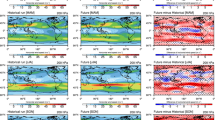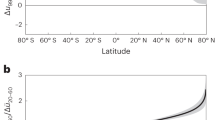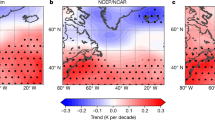Abstract
Atmospheric turbulence causes most weather-related aircraft incidents1. Commercial aircraft encounter moderate-or-greater turbulence tens of thousands of times each year worldwide, injuring probably hundreds of passengers (occasionally fatally), costing airlines tens of millions of dollars and causing structural damage to planes1,2,3. Clear-air turbulence is especially difficult to avoid, because it cannot be seen by pilots or detected by satellites or on-board radar4,5. Clear-air turbulence is linked to atmospheric jet streams6,7, which are projected to be strengthened by anthropogenic climate change8. However, the response of clear-air turbulence to projected climate change has not previously been studied. Here we show using climate model simulations that clear-air turbulence changes significantly within the transatlantic flight corridor when the concentration of carbon dioxide in the atmosphere is doubled. At cruise altitudes within 50–75° N and 10–60° W in winter, most clear-air turbulence measures show a 10–40% increase in the median strength of turbulence and a 40–170% increase in the frequency of occurrence of moderate-or-greater turbulence. Our results suggest that climate change will lead to bumpier transatlantic flights by the middle of this century. Journey times may lengthen and fuel consumption and emissions may increase. Aviation is partly responsible for changing the climate9, but our findings show for the first time how climate change could affect aviation.
This is a preview of subscription content, access via your institution
Access options
Subscribe to this journal
Receive 12 print issues and online access
$209.00 per year
only $17.42 per issue
Buy this article
- Purchase on Springer Link
- Instant access to full article PDF
Prices may be subject to local taxes which are calculated during checkout



Similar content being viewed by others
References
Sharman, R., Tebaldi, C., Wiener, G. & Wolff, J. An integrated approach to mid- and upper-level turbulence forecasting. Weather Forecast. 21, 268–287 (2006).
Clark, T. L. et al. Origins of aircraft-damaging clear-air turbulence during the 9 December 1992 Colorado downslope windstorm: Numerical simulations and comparison with observations. J. Atmos. Sci. 57, 1105–1131 (2000).
Sharman, R. D., Trier, S. B., Lane, T. P. & Doyle, J. D. Sources and dynamics of turbulence in the upper troposphere and lower stratosphere: A review. Geophys. Res. Lett. 39, L12803 (2012).
Kennedy, P. J. & Shapiro, M. A. Further encounters with clear air turbulence in research aircraft. J. Atmos. Sci. 37, 986–993 (1980).
Knox, J. A. Possible mechanisms of clear-air turbulence in strongly anticyclonic flows. Mon. Weath. Rev. 125, 1251–1259 (1997).
Reiter, E. R. & Nania, A. Jet-stream structure and clear-air turbulence (CAT). J. Appl. Meteorol. 3, 247–260 (1964).
Koch, S. E. et al. Turbulence and gravity waves within an upper-level front. J. Atmos. Sci. 62, 3885–3908 (2005).
Lorenz, D. J. & DeWeaver, E. T. Tropopause height and zonal wind response to global warming in the IPCC scenario integrations. J. Geophys. Res. 112, D10119 (2007).
Stuber, N., Forster, P., Rädel, G. & Shine, K. The importance of the diurnal and annual cycle of air traffic for contrail radiative forcing. Nature 441, 864–867 (2006).
Lane, T. P., Sharman, R. D., Trier, S. B., Fovell, R. G. & Williams, J. K. Recent advances in the understanding of near-cloud turbulence. Bull. Am. Meteorol. Soc. 93, 499–515 (2012).
Watkins, C. D. & Browning, K. A. The detection of clear air turbulence by radar. Phys. Technol. 4, 28–61 (1973).
Harrison, R. G., Heath, A. M., Hogan, R. J. & Rogers, G. W. Comparison of balloon-carried atmospheric motion sensors with Doppler lidar turbulence measurements. Rev. Scient. Inst. 80, 026108 (2009).
McCann, D. W. Gravity waves, unbalanced flow, and clear air turbulence. Natl Weath. Digest. 25, 3–14 (2001).
Colson, D. & Panofsky, H. A. An index of clear-air turbulence. Q. J. R. Meteorol. Soc. 91, 507–513 (1965).
Brown, R. New indices to locate clear-air turbulence. Meteorol. Mag. 102, 347–360 (1973).
Ellrod, G. P. & Knapp, D. L. An objective clear-air turbulence forecasting technique: Verification and operational use. Weather Forecast. 7, 150–165 (1992).
Jaeger, E. B. & Sprenger, M. A Northern Hemispheric climatology of indices for clear air turbulence in the tropopause region derived from ERA40 reanalysis data. J. Geophys. Res. 112, D20106 (2007).
Williams, P. D., Haine, T. W. N & Read, P. L. On the generation mechanisms of short-scale unbalanced modes in rotating two-layer flows with vertical shear. J. Fluid Mech. 528, 1–22 (2005).
Williams, P. D., Haine, T. W. N. & Read, P. L. Inertia–gravity waves emitted from balanced flow: Observations, properties, and consequences. J. Atmos. Sci. 65, 3543–3556 (2008).
Knox, J. A., McCann, D. W. & Williams, P. D. Application of the Lighthill–Ford theory of spontaneous imbalance to clear-air turbulence forecasting. J. Atmos. Sci. 65, 3292–3304 (2008).
McCann, D. W., Knox, J. A. & Williams, P. D. An improvement in clear-air turbulence forecasting based on spontaneous imbalance theory: the ULTURB algorithm. Meteorol. Appl. 19, 71–78 (2012).
Gill, P. G. Objective verification of World Area Forecast Centre clear-air turbulence forecasts. Meteorol. Appl. http://dx.doi.org/10.1002/met.1288 (2012).
Wolff, J. K. & Sharman, R. D. Climatology of upper-level turbulence over the contiguous United States. J. Appl. Meteorol. Climatol. 47, 2198–2214 (2008).
Delworth, T. L. et al. GFDL’s CM2 global coupled climate models. Part I: Formulation and simulation characteristics. J. Clim. 19, 643–674 (2006).
Gnanadesikan, A. et al. GFDL’s CM2 global coupled climate models. Part II: The baseline ocean simulation. J. Clim. 19, 675–697 (2006).
Meehl, G. A. et al. in IPCC Climate Change 2007: The Physical Science Basis (eds Solomon, S. et al.) Ch. 10, 747–846 (Cambridge Univ. Press, 2007).
Irvine, E. A., Hoskins, B. J., Shine, K. P., Lunnon, R. W. & Froemming, C. Characterizing North Atlantic weather patterns for climate-optimal aircraft routing. Meteorol. Appl. 20, 80–93 (2013).
Stouffer, R. J. et al. GFDL’s CM2 global coupled climate models. Part IV: Idealized climate response. J. Clim. 19, 723–740 (2006).
Meehl, G. A. et al. The WCRP CMIP3 multi-model dataset: A new era in climate change research. Bull. Am. Meteorol. Soc. 88, 1383–1394 (2007).
Reichler, T. & Kim, J. Uncertainties in the climate mean state of global observations, reanalyses, and the GFDL climate model. J. Geophys. Res. 113, D05106 (2008).
Acknowledgements
P.D.W. is financially supported through a University Research Fellowship from the Royal Society (reference: UF080256). The authors acknowledge the modelling groups, the Program for Climate Model Diagnosis and Intercomparison (PCMDI) and the WCRP’s Working Group on Coupled Modelling (WGCM) for their roles in making available the WCRP CMIP3 multi-model data set. Support of this data set is provided by the Office of Science, US Department of Energy. The authors thank A. Turner for facilitating access to the data set. The authors thank E. Irvine and L. Wilcox for supplying information about flight routes, which were calculated using the Aviation Environmental Design Tool (AEDT) from the US Federal Aviation Administration (FAA).
Author information
Authors and Affiliations
Contributions
P.D.W. and M.M.J. jointly conceived the study. P.D.W. computed the turbulence diagnostics, produced the figures and wrote the paper with input from M.M.J. The authors discussed the results and implications with each other at all stages.
Corresponding author
Ethics declarations
Competing interests
The authors declare no competing financial interests.
Rights and permissions
About this article
Cite this article
Williams, P., Joshi, M. Intensification of winter transatlantic aviation turbulence in response to climate change. Nature Clim Change 3, 644–648 (2013). https://doi.org/10.1038/nclimate1866
Received:
Accepted:
Published:
Issue Date:
DOI: https://doi.org/10.1038/nclimate1866
This article is cited by
-
Fast upper-level jet stream winds get faster under climate change
Nature Climate Change (2024)
-
Detection of Turbulence Anomalies Using a Symbolic Classifier Algorithm in Airborne Quick Access Record (QAR) Data Analysis
Advances in Atmospheric Sciences (2024)
-
Using sub-limb observations to measure gravity waves excited by convection
npj Microgravity (2023)
-
Global response of upper-level aviation turbulence from various sources to climate change
npj Climate and Atmospheric Science (2023)
-
Clear-air turbulence trends over the North Atlantic in high-resolution climate models
Climate Dynamics (2023)



